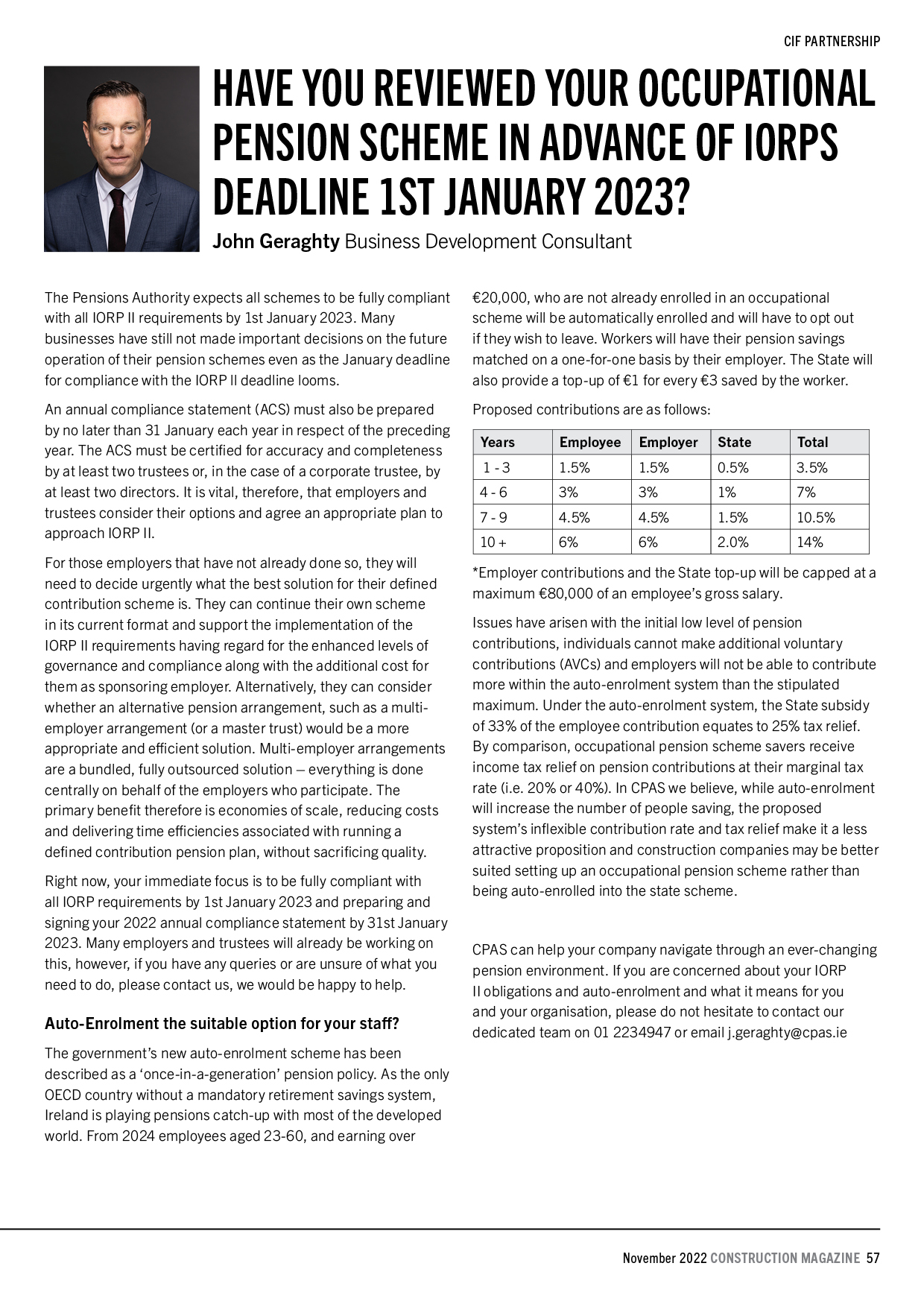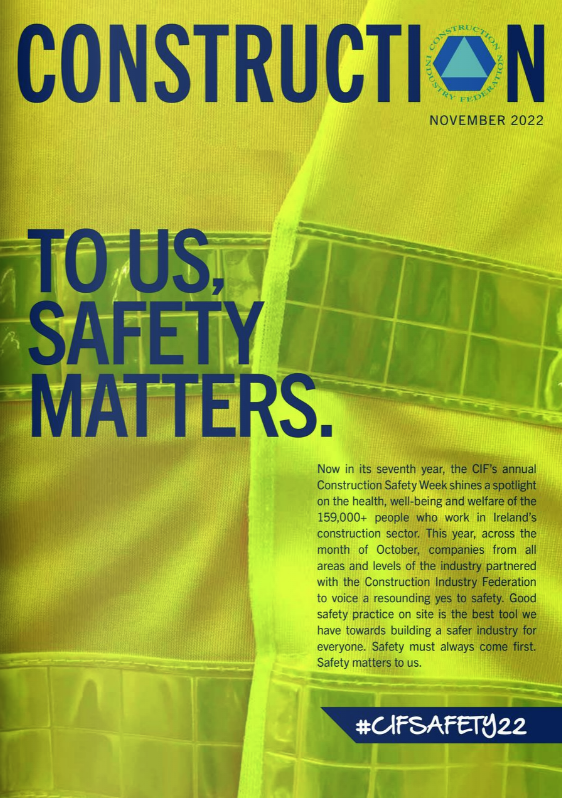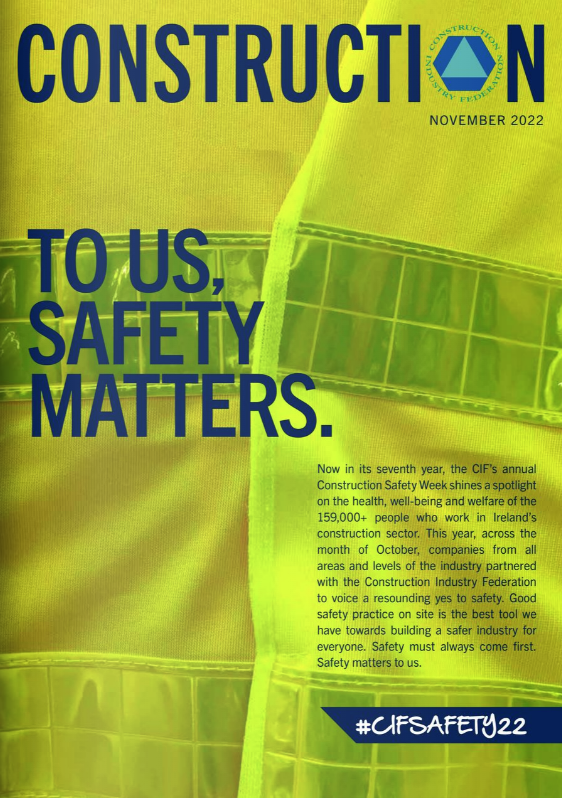In the latest edition of Construction Magazine, John Geraghty examines the impact of both IORP II deadline and Auto Enrolment.
By the time January 1st 2023 rolls around, the Pensions Authority expects all pension schemes to be fully compliant with all IORP II requirements. There are some organisations that have yet to make the important decisions on the future operation of their pension schemes even as the January deadline for compliance with the IORP ll deadline looms.
An Annual Compliance Statement (ACS) must also be prepared by no later than 31 January each year in respect of the preceding year. The ACS must be certified for accuracy and completeness by at least two trustees or, in the case of a corporate trustee, by at least two directors. It is vital, therefore, that employers and trustees consider their options and agree appropriate processes to manage IORP II compliance.
Making a decision

For those employers who have not already done so, they will need to decide urgently what the best solution for their defined contribution scheme is. For those who wish to continue administering their own scheme in its current format, it is possible to do so long as they support the implementation of the IORP II requirements. They must also be mindful of the enhanced levels of governance and compliance along with the additional costs incurred as a sponsoring employer.
Alternatively, for those who do not wish to take on the arduous tasks of self-administering a scheme, employers can consider an alternative pension arrangement, such as a multi-employer arrangement (or a Master Trust), which might be a more appropriate and efficient solution.
Finding a solution
Multi-employer arrangements are a bundled, fully outsourced solution. Everything is administered centrally on behalf of participating employers. The primary benefit therefore is economies of scale, a reduction in costs and delivery of time efficiencies associated with running a defined contribution pension plan, without sacrificing quality or compliance.
Right now, your immediate focus should be firmly on IORP II by 1st January 2023 and preparing and signing your 2022 annual compliance statement by 31st January 2023.
Many employers and trustees will already be working on this, however, if you have any queries or are unsure of what you need to do, please contact us, we would be happy to help.
Waiting for Auto-Enrolment or taking proactive steps?
The government’s proposed auto-enrolment scheme has been described as a ‘once-in-a-generation’ pension policy. As the only OECD country without a mandatory retirement savings system, Ireland is playing “pensions catch-up” with most of the developed world.
From 2024 employees aged 23-60, earning over €20,000, who are not already enrolled in an occupational scheme will be automatically enrolled. They will have to opt-out if they wish to leave. Workers will have their pension savings matched on a one-for-one basis by their employer. The State will also provide a top-up of €1 for every €3 saved by the employee.
There are the proposed contributions provided for by the government:
| 1 – 3 | 1.5% | 1.5% | 0.5% | 3.5% |
| 4 – 6 | 3% | 3% | 1% | 7% |
| 7 – 9 | 4.5% | 4.5% | 1.5% | 10.5% |
| 10 + | 6% | 6% | 2% | 14% |
*Employer contributions and the State top-up will be capped at a maximum €80,000 of an employee’s gross salary.
Additional Considerations

Issues have arisen with the initial low level of pension contributions but in addition, individuals will be unable to make Additional Voluntary Contributions (AVCs). Employers who wish to top up the minimum amount will not be able to contribute more than the stipulated maximum.
Under the auto-enrolment system, the State subsidy of 33% of the employee contribution equates to 25% tax relief. By comparison, for Members of an occupational pension scheme, they will receive income tax relief on pension contributions at their marginal tax rate (i.e. 20% or 40%).
In CPAS, we believe, while auto-enrolment will increase the number of people saving for their retirement, the proposed system’s inflexible contribution rate and tax relief make it a less attractive proposition. As a consequence, construction companies may be better suited setting up an occupational pension scheme rather than being auto-enrolled into the State scheme. This is especially attractive to those employers’ who are looking to attract and retain skilled staff.
CPAS – Pension Specialists Serving the Construction Sector
If you are concerned about your IORP II and auto-enrolment obligations, the CPAS team can help you navigate the vast amount of information, explaining how it will impact you, your organisation and employees. Most importantly, we’ll guide you along the way, helping you maximise your investment – whether it is in your staff or your future.






